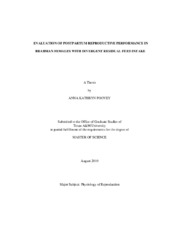| dc.description.abstract | These studies were designed to evaluate the relationships that exist between
residual feed intake, parity, rate of return to estrous cyclicity and nonesterified fatty acid
(NEFA) concentrations, as well as changes in both body weight (BW) and body
condition score (BCS) during the prepartum and postpartum time periods in Brahman
females. Residual feed intake classification was evaluated for all females during the
course of 70-d trials conducted prior to these experiments. Heifers (n = 30) and cows (n
= 63) were evaluated for BW and BCS, as well as by collection of weekly blood samples
beginning five weeks prior to calving. Blood serum samples were utilized to assay for
NEFA concentrations by enzymatic colorimetry both pre- and postpartum. Multiparous
females (n = 44) were sampled weekly for five weeks following parturition. Beginning
28d postpartum, weekly blood samples were collected and assayed for progesterone
concentrations by radioimmunoassay to determine return to estrous cyclicity. Following
calving, females were exposed to epididymectomized bulls fitted with chin-ball markers to aid in estrus detection. After detection, estrus females were evaluated for presence of
a corpus luteum by trans-rectal ultrasonography.
Prepartum, it was found that inefficient females had a greater BCS than efficient
females (P < 0.05), significant BW changes occurred during the sampling period (P <
0.05) and moderate to low correlations existed between BW and BCS. Additionally, it
was found that the interaction between RFI x parity had a significant affect upon NEFA
concentrations, BW and BCS (P < 0.05). During the postpartum period it was found that
efficient females were lower in both BW and BCS (P < 0.05), no change occurred over
time in NEFA concentrations (P > 0.1) and a greater pregnancy rate was achieved in
efficient females, as well as in females that returned to estrous cyclicity rapidly (< 90d)
following calving. | en |


